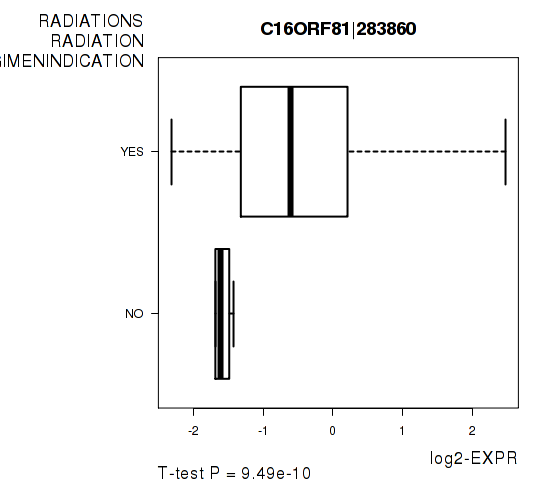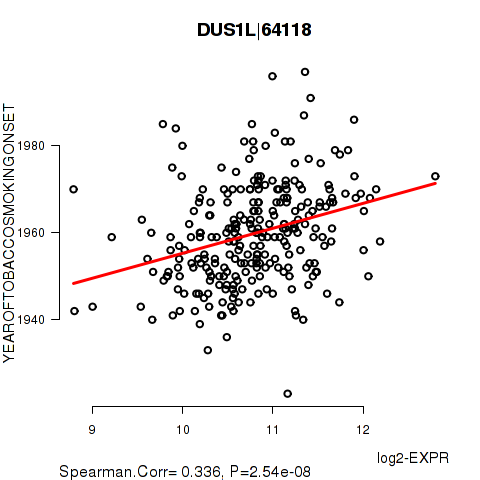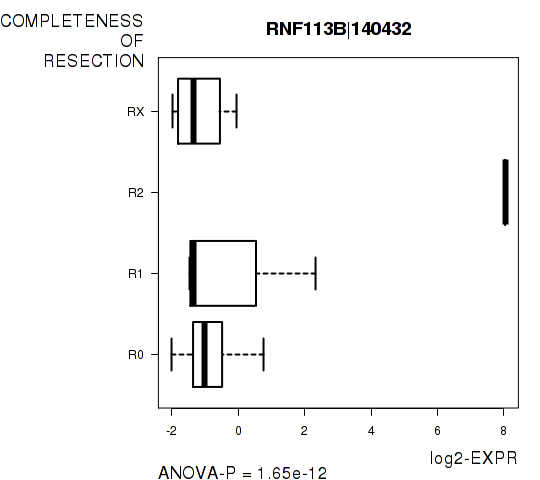This pipeline uses various statistical tests to identify mRNAs whose expression levels correlated to selected clinical features.
Testing the association between 18519 genes and 13 clinical features across 398 samples, statistically thresholded by Q value < 0.05, 11 clinical features related to at least one genes.
-
4 genes correlated to 'AGE'.
-
PRSS12|8492 , GLB1L|79411 , GLI3|2737 , EYA2|2139
-
5 genes correlated to 'NEOPLASM.DISEASESTAGE'.
-
CENPE|1062 , CA4|762 , CLDN18|51208 , AGER|177 , KIT|3815
-
6 genes correlated to 'PATHOLOGY.T.STAGE'.
-
SFTPC|6440 , AGER|177 , GDF10|2662 , ADH1B|125 , CNR1|1268 , ...
-
1 gene correlated to 'PATHOLOGY.N.STAGE'.
-
KPNA2|3838
-
11 genes correlated to 'PATHOLOGY.M.STAGE'.
-
DEDD|9191 , SDHC|6391 , PEX19|5824 , PPIAL4G|644591 , NUDCD1|84955 , ...
-
47 genes correlated to 'GENDER'.
-
XIST|7503 , ZFY|7544 , PRKY|5616 , RPS4Y1|6192 , TSIX|9383 , ...
-
8 genes correlated to 'KARNOFSKY.PERFORMANCE.SCORE'.
-
PPIAL4G|644591 , C16ORF79|283870 , LUC7L3|51747 , NKTR|4820 , FLJ10213|55096 , ...
-
21 genes correlated to 'HISTOLOGICAL.TYPE'.
-
SNIP1|79753 , SF3A3|10946 , XIAP|331 , UTP11L|51118 , GNL2|29889 , ...
-
5 genes correlated to 'RADIATIONS.RADIATION.REGIMENINDICATION'.
-
C16ORF81|283860 , FLJ36000|284124 , RTP1|132112 , IL19|29949 , GAGE12J|729396
-
7 genes correlated to 'YEAROFTOBACCOSMOKINGONSET'.
-
DUS1L|64118 , C17ORF56|146705 , LOC729020|729020 , C16ORF79|283870 , CCDC154|645811 , ...
-
4 genes correlated to 'COMPLETENESS.OF.RESECTION'.
-
RNF113B|140432 , ATP4B|496 , LYRM4|57128 , SRGAP2|23380
-
No genes correlated to 'Time to Death', and 'NUMBERPACKYEARSSMOKED'.
Complete statistical result table is provided in Supplement Table 1
Table 1. Get Full Table This table shows the clinical features, statistical methods used, and the number of genes that are significantly associated with each clinical feature at Q value < 0.05.
| Clinical feature | Statistical test | Significant genes | Associated with | Associated with | ||
|---|---|---|---|---|---|---|
| Time to Death | Cox regression test | N=0 | ||||
| AGE | Spearman correlation test | N=4 | older | N=4 | younger | N=0 |
| NEOPLASM DISEASESTAGE | ANOVA test | N=5 | ||||
| PATHOLOGY T STAGE | Spearman correlation test | N=6 | higher stage | N=0 | lower stage | N=6 |
| PATHOLOGY N STAGE | Spearman correlation test | N=1 | higher stage | N=1 | lower stage | N=0 |
| PATHOLOGY M STAGE | ANOVA test | N=11 | ||||
| GENDER | t test | N=47 | male | N=14 | female | N=33 |
| KARNOFSKY PERFORMANCE SCORE | Spearman correlation test | N=8 | higher score | N=7 | lower score | N=1 |
| HISTOLOGICAL TYPE | ANOVA test | N=21 | ||||
| RADIATIONS RADIATION REGIMENINDICATION | t test | N=5 | yes | N=5 | no | N=0 |
| NUMBERPACKYEARSSMOKED | Spearman correlation test | N=0 | ||||
| YEAROFTOBACCOSMOKINGONSET | Spearman correlation test | N=7 | higher yearoftobaccosmokingonset | N=6 | lower yearoftobaccosmokingonset | N=1 |
| COMPLETENESS OF RESECTION | ANOVA test | N=4 |
Table S1. Basic characteristics of clinical feature: 'Time to Death'
| Time to Death | Duration (Months) | 0-173.8 (median=13.2) |
| censored | N = 235 | |
| death | N = 135 | |
| Significant markers | N = 0 |
Table S2. Basic characteristics of clinical feature: 'AGE'
| AGE | Mean (SD) | 67.12 (8.7) |
| Significant markers | N = 4 | |
| pos. correlated | 4 | |
| neg. correlated | 0 |
Table S3. Get Full Table List of 4 genes significantly correlated to 'AGE' by Spearman correlation test
| SpearmanCorr | corrP | Q | |
|---|---|---|---|
| PRSS12|8492 | 0.2897 | 5.884e-09 | 0.000109 |
| GLB1L|79411 | 0.2615 | 1.608e-07 | 0.00298 |
| GLI3|2737 | 0.2603 | 1.846e-07 | 0.00342 |
| EYA2|2139 | 0.2354 | 2.676e-06 | 0.0495 |
Figure S1. Get High-res Image As an example, this figure shows the association of PRSS12|8492 to 'AGE'. P value = 5.88e-09 with Spearman correlation analysis. The straight line presents the best linear regression.

Table S4. Basic characteristics of clinical feature: 'NEOPLASM.DISEASESTAGE'
| NEOPLASM.DISEASESTAGE | Labels | N |
| STAGE I | 2 | |
| STAGE IA | 69 | |
| STAGE IB | 129 | |
| STAGE II | 1 | |
| STAGE IIA | 50 | |
| STAGE IIB | 67 | |
| STAGE IIIA | 53 | |
| STAGE IIIB | 19 | |
| STAGE IV | 5 | |
| Significant markers | N = 5 |
Table S5. Get Full Table List of 5 genes differentially expressed by 'NEOPLASM.DISEASESTAGE'
| ANOVA_P | Q | |
|---|---|---|
| CENPE|1062 | 5.109e-08 | 0.000946 |
| CA4|762 | 1.433e-07 | 0.00265 |
| CLDN18|51208 | 6.877e-07 | 0.0127 |
| AGER|177 | 1.126e-06 | 0.0209 |
| KIT|3815 | 2.204e-06 | 0.0408 |
Figure S2. Get High-res Image As an example, this figure shows the association of CENPE|1062 to 'NEOPLASM.DISEASESTAGE'. P value = 5.11e-08 with ANOVA analysis.

Table S6. Basic characteristics of clinical feature: 'PATHOLOGY.T.STAGE'
| PATHOLOGY.T.STAGE | Mean (SD) | 1.96 (0.73) |
| N | ||
| 1 | 95 | |
| 2 | 241 | |
| 3 | 44 | |
| 4 | 18 | |
| Significant markers | N = 6 | |
| pos. correlated | 0 | |
| neg. correlated | 6 |
Table S7. Get Full Table List of 6 genes significantly correlated to 'PATHOLOGY.T.STAGE' by Spearman correlation test
| SpearmanCorr | corrP | Q | |
|---|---|---|---|
| SFTPC|6440 | -0.2653 | 9.381e-08 | 0.00174 |
| AGER|177 | -0.2494 | 4.681e-07 | 0.00867 |
| GDF10|2662 | -0.2435 | 1.419e-06 | 0.0263 |
| ADH1B|125 | -0.2378 | 2.043e-06 | 0.0378 |
| CNR1|1268 | -0.2367 | 2.085e-06 | 0.0386 |
| PGC|5225 | -0.2428 | 2.294e-06 | 0.0425 |
Figure S3. Get High-res Image As an example, this figure shows the association of SFTPC|6440 to 'PATHOLOGY.T.STAGE'. P value = 9.38e-08 with Spearman correlation analysis.

Table S8. Basic characteristics of clinical feature: 'PATHOLOGY.N.STAGE'
| PATHOLOGY.N.STAGE | Mean (SD) | 0.47 (0.7) |
| N | ||
| 0 | 251 | |
| 1 | 104 | |
| 2 | 33 | |
| 3 | 5 | |
| Significant markers | N = 1 | |
| pos. correlated | 1 | |
| neg. correlated | 0 |
Table S9. Get Full Table List of one gene significantly correlated to 'PATHOLOGY.N.STAGE' by Spearman correlation test
| SpearmanCorr | corrP | Q | |
|---|---|---|---|
| KPNA2|3838 | 0.2358 | 2.275e-06 | 0.0421 |
Figure S4. Get High-res Image As an example, this figure shows the association of KPNA2|3838 to 'PATHOLOGY.N.STAGE'. P value = 2.28e-06 with Spearman correlation analysis.

Table S10. Basic characteristics of clinical feature: 'PATHOLOGY.M.STAGE'
| PATHOLOGY.M.STAGE | Labels | N |
| M0 | 340 | |
| M1 | 5 | |
| MX | 47 | |
| Significant markers | N = 11 |
Table S11. Get Full Table List of top 10 genes differentially expressed by 'PATHOLOGY.M.STAGE'
| ANOVA_P | Q | |
|---|---|---|
| DEDD|9191 | 2.638e-08 | 0.000489 |
| SDHC|6391 | 9.214e-08 | 0.00171 |
| PEX19|5824 | 4.359e-07 | 0.00807 |
| PPIAL4G|644591 | 5.014e-07 | 0.00928 |
| NUDCD1|84955 | 5.261e-07 | 0.00974 |
| POLE3|54107 | 6.556e-07 | 0.0121 |
| TMCO1|54499 | 7.174e-07 | 0.0133 |
| C1ORF43|25912 | 1.645e-06 | 0.0305 |
| POTEF|728378 | 1.927e-06 | 0.0357 |
| CKS1B|1163 | 2.411e-06 | 0.0446 |
Figure S5. Get High-res Image As an example, this figure shows the association of DEDD|9191 to 'PATHOLOGY.M.STAGE'. P value = 2.64e-08 with ANOVA analysis.

Table S12. Basic characteristics of clinical feature: 'GENDER'
| GENDER | Labels | N |
| FEMALE | 99 | |
| MALE | 299 | |
| Significant markers | N = 47 | |
| Higher in MALE | 14 | |
| Higher in FEMALE | 33 |
Table S13. Get Full Table List of top 10 genes differentially expressed by 'GENDER'
| T(pos if higher in 'MALE') | ttestP | Q | AUC | |
|---|---|---|---|---|
| XIST|7503 | -39.74 | 2.959e-119 | 5.48e-115 | 0.9778 |
| ZFY|7544 | 43.64 | 1.49e-80 | 2.76e-76 | 0.9994 |
| PRKY|5616 | 28.25 | 3.325e-68 | 6.15e-64 | 0.9862 |
| RPS4Y1|6192 | 39.73 | 3.884e-59 | 7.19e-55 | 1 |
| TSIX|9383 | -19.35 | 8.592e-49 | 1.59e-44 | 0.9579 |
| DDX3Y|8653 | 34.2 | 9.7e-41 | 1.8e-36 | 1 |
| KDM5D|8284 | 38.3 | 1.122e-40 | 2.08e-36 | 1 |
| NLGN4Y|22829 | 22.69 | 5.673e-33 | 1.05e-28 | 0.9889 |
| USP9Y|8287 | 27.19 | 1.704e-27 | 3.15e-23 | 0.998 |
| CYORF15A|246126 | 25.11 | 2.857e-22 | 5.29e-18 | 0.9976 |
Figure S6. Get High-res Image As an example, this figure shows the association of XIST|7503 to 'GENDER'. P value = 2.96e-119 with T-test analysis.

8 genes related to 'KARNOFSKY.PERFORMANCE.SCORE'.
Table S14. Basic characteristics of clinical feature: 'KARNOFSKY.PERFORMANCE.SCORE'
| KARNOFSKY.PERFORMANCE.SCORE | Mean (SD) | 50.45 (42) |
| Significant markers | N = 8 | |
| pos. correlated | 7 | |
| neg. correlated | 1 |
Table S15. Get Full Table List of 8 genes significantly correlated to 'KARNOFSKY.PERFORMANCE.SCORE' by Spearman correlation test
| SpearmanCorr | corrP | Q | |
|---|---|---|---|
| PPIAL4G|644591 | -0.5373 | 6.776e-08 | 0.00125 |
| C16ORF79|283870 | 0.5227 | 1.747e-07 | 0.00324 |
| LUC7L3|51747 | 0.5218 | 1.852e-07 | 0.00343 |
| NKTR|4820 | 0.5079 | 4.395e-07 | 0.00814 |
| FLJ10213|55096 | 0.5066 | 4.763e-07 | 0.00882 |
| WDR27|253769 | 0.4996 | 7.208e-07 | 0.0133 |
| LOC90834|90834 | 0.4917 | 1.144e-06 | 0.0212 |
| SULT1A3|6818 | 0.4804 | 2.172e-06 | 0.0402 |
Figure S7. Get High-res Image As an example, this figure shows the association of PPIAL4G|644591 to 'KARNOFSKY.PERFORMANCE.SCORE'. P value = 6.78e-08 with Spearman correlation analysis. The straight line presents the best linear regression.

Table S16. Basic characteristics of clinical feature: 'HISTOLOGICAL.TYPE'
| HISTOLOGICAL.TYPE | Labels | N |
| LUNG BASALOID SQUAMOUS CELL CARCINOMA | 11 | |
| LUNG PAPILLARY SQUAMOUS CELL CARICNOMA | 6 | |
| LUNG SMALL CELL SQUAMOUS CELL CARCINOMA | 1 | |
| LUNG SQUAMOUS CELL CARCINOMA- NOT OTHERWISE SPECIFIED (NOS) | 380 | |
| Significant markers | N = 21 |
Table S17. Get Full Table List of top 10 genes differentially expressed by 'HISTOLOGICAL.TYPE'
| ANOVA_P | Q | |
|---|---|---|
| SNIP1|79753 | 6.284e-26 | 1.16e-21 |
| SF3A3|10946 | 1.026e-24 | 1.9e-20 |
| XIAP|331 | 2.578e-20 | 4.77e-16 |
| UTP11L|51118 | 4.699e-20 | 8.7e-16 |
| GNL2|29889 | 4.322e-18 | 8e-14 |
| C1ORF109|54955 | 1.977e-17 | 3.66e-13 |
| MEAF6|64769 | 4.374e-16 | 8.1e-12 |
| INPP5B|3633 | 5.637e-16 | 1.04e-11 |
| C1ORF122|127687 | 4.847e-11 | 8.97e-07 |
| MTF1|4520 | 7.34e-11 | 1.36e-06 |
Figure S8. Get High-res Image As an example, this figure shows the association of SNIP1|79753 to 'HISTOLOGICAL.TYPE'. P value = 6.28e-26 with ANOVA analysis.

5 genes related to 'RADIATIONS.RADIATION.REGIMENINDICATION'.
Table S18. Basic characteristics of clinical feature: 'RADIATIONS.RADIATION.REGIMENINDICATION'
| RADIATIONS.RADIATION.REGIMENINDICATION | Labels | N |
| NO | 11 | |
| YES | 387 | |
| Significant markers | N = 5 | |
| Higher in YES | 5 | |
| Higher in NO | 0 |
Table S19. Get Full Table List of 5 genes differentially expressed by 'RADIATIONS.RADIATION.REGIMENINDICATION'
| T(pos if higher in 'YES') | ttestP | Q | AUC | |
|---|---|---|---|---|
| C16ORF81|283860 | 11.54 | 9.488e-10 | 1.75e-05 | 0.8901 |
| FLJ36000|284124 | 11.84 | 2.595e-09 | 4.79e-05 | 0.8938 |
| RTP1|132112 | 8.43 | 9.941e-07 | 0.0184 | 0.8609 |
| IL19|29949 | 9.37 | 1.403e-06 | 0.0259 | 0.868 |
| GAGE12J|729396 | 7.74 | 2.102e-06 | 0.0388 | 0.7381 |
Figure S9. Get High-res Image As an example, this figure shows the association of C16ORF81|283860 to 'RADIATIONS.RADIATION.REGIMENINDICATION'. P value = 9.49e-10 with T-test analysis.

Table S20. Basic characteristics of clinical feature: 'NUMBERPACKYEARSSMOKED'
| NUMBERPACKYEARSSMOKED | Mean (SD) | 52.66 (32) |
| Significant markers | N = 0 |
Table S21. Basic characteristics of clinical feature: 'YEAROFTOBACCOSMOKINGONSET'
| YEAROFTOBACCOSMOKINGONSET | Mean (SD) | 1959.79 (12) |
| Significant markers | N = 7 | |
| pos. correlated | 6 | |
| neg. correlated | 1 |
Table S22. Get Full Table List of 7 genes significantly correlated to 'YEAROFTOBACCOSMOKINGONSET' by Spearman correlation test
| SpearmanCorr | corrP | Q | |
|---|---|---|---|
| DUS1L|64118 | 0.3357 | 2.541e-08 | 0.000471 |
| C17ORF56|146705 | 0.3022 | 6.184e-07 | 0.0115 |
| LOC729020|729020 | -0.2956 | 1.106e-06 | 0.0205 |
| C16ORF79|283870 | 0.2931 | 1.384e-06 | 0.0256 |
| CCDC154|645811 | 0.2985 | 1.773e-06 | 0.0328 |
| EME1|146956 | 0.2889 | 1.978e-06 | 0.0366 |
| LOC146880|146880 | 0.2879 | 2.146e-06 | 0.0397 |
Figure S10. Get High-res Image As an example, this figure shows the association of DUS1L|64118 to 'YEAROFTOBACCOSMOKINGONSET'. P value = 2.54e-08 with Spearman correlation analysis. The straight line presents the best linear regression.

Table S23. Basic characteristics of clinical feature: 'COMPLETENESS.OF.RESECTION'
| COMPLETENESS.OF.RESECTION | Labels | N |
| R0 | 322 | |
| R1 | 8 | |
| R2 | 4 | |
| RX | 18 | |
| Significant markers | N = 4 |
Table S24. Get Full Table List of 4 genes differentially expressed by 'COMPLETENESS.OF.RESECTION'
| ANOVA_P | Q | |
|---|---|---|
| RNF113B|140432 | 1.647e-12 | 3.05e-08 |
| ATP4B|496 | 1.153e-06 | 0.0213 |
| LYRM4|57128 | 1.44e-06 | 0.0267 |
| SRGAP2|23380 | 2.195e-06 | 0.0406 |
Figure S11. Get High-res Image As an example, this figure shows the association of RNF113B|140432 to 'COMPLETENESS.OF.RESECTION'. P value = 1.65e-12 with ANOVA analysis.

-
Expresson data file = LUSC-TP.uncv2.mRNAseq_RSEM_normalized_log2.txt
-
Clinical data file = LUSC-TP.merged_data.txt
-
Number of patients = 398
-
Number of genes = 18519
-
Number of clinical features = 13
For survival clinical features, Wald's test in univariate Cox regression analysis with proportional hazards model (Andersen and Gill 1982) was used to estimate the P values using the 'coxph' function in R. Kaplan-Meier survival curves were plot using the four quartile subgroups of patients based on expression levels
For continuous numerical clinical features, Spearman's rank correlation coefficients (Spearman 1904) and two-tailed P values were estimated using 'cor.test' function in R
For multi-class clinical features (ordinal or nominal), one-way analysis of variance (Howell 2002) was applied to compare the log2-expression levels between different clinical classes using 'anova' function in R
For two-class clinical features, two-tailed Student's t test with unequal variance (Lehmann and Romano 2005) was applied to compare the log2-expression levels between the two clinical classes using 't.test' function in R
For multiple hypothesis correction, Q value is the False Discovery Rate (FDR) analogue of the P value (Benjamini and Hochberg 1995), defined as the minimum FDR at which the test may be called significant. We used the 'Benjamini and Hochberg' method of 'p.adjust' function in R to convert P values into Q values.
In addition to the links below, the full results of the analysis summarized in this report can also be downloaded programmatically using firehose_get, or interactively from either the Broad GDAC website or TCGA Data Coordination Center Portal.